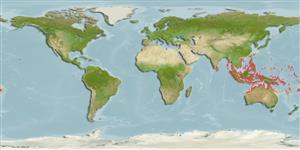Environment: milieu / climate zone / depth range / distribution range
Ecologia
marinhas; estuarina associadas(os) a recifes; intervalo de profundidade 0 - 20 m (Ref. 48637), usually 0 - 15 m (Ref. 90102). Tropical; 19°C - 38°C (Ref. 1827); 30°N - 30°S, 77°E - 20°W
Indo-West Pacific: India, Sri Lanka, Andaman Islands, Thailand, Malaysia, Singapore, Indonesia, Philippines, Belau [=Palau], Guam, New Guinea, Solomon Islands, Fiji, Vanuatu, ?New Caledonia, ?Western Australia, ?Pohnpei, Caroline Islands, ?Ebon Island and Marshall Islands.
Tamanho / Peso / Idade
Maturity: Lm ? range ? - ? cm
Max length : 45.0 cm TL macho/indeterminado; (Ref. 1419); common length : 30.0 cm TL macho/indeterminado; (Ref. 9813); peso máx. Publicado: 2.4 kg (Ref. 125599)
Espinhos dorsais (total): 13; Raios dorsais moles (total): 10; Espinhos anais 7; Raios anais moles: 9; Vértebras: 13. Body bluish white; head brown to brownish or golden yellow with irregular blue lines. Preopercular angle 91°-102°; strong overlapping scales cover cheeks; midline of thorax scaled, not pelvic ridges. Anterior nostril with low flange, broadened slightly posteriorly. Spines stout, blunt or pungent, and venomous.
Juveniles live among mangroves then move out to lagoon and coastal reefs as they mature. Forms schools. Feeds on algae growing on seagrasses, mangrove roots and rocks. Adults congregate inshore in groups of several hundreds to spawn in summer. Spawning is by pairs; sticky eggs laid on the bottom. Its very high quality flesh commands premium prices (Ref. 9813). Adults on coastal reefs, subject to strong currents (Ref. 48637). This species can tolerate very low salinities (2 ppt) and temperatures up to 38 C (Ref. 37816).
Throughout summer, adults form inshore breeding groups of several hundred individuals on the 7th or 8th days of the lunar month; pairs break from these groups to spawn. The species has a high fecundity of 350,000/spawning season.
Woodland, D.J., 1990. Revision of the fish family Siganidae with descriptions of two new species and comments on distribution and biology. Indo-Pac. Fish. (19):136 p. (Ref. 1419)
Categoria na Lista Vermelha da IUCN (Ref. 130435)
Utilização humana
Pescarias: espécies comerciais; Aquacultura: uso futuro provável; Aquário: Espécies comerciais
Mais informação
ReferênciasAquaculturaPerfil para aquaculturaEstirpesGenéticaElectrophoresesHereditariedadeDoençasProcessamentoNutrientsMass conversion
ColaboradoresFotografiasStamps, Coins Misc.SonsCiguateraVelocidadeTipo de nataçãoÁrea branquialOutras referênciasCérebrosVisão
Ferramentas
Relatórios especiais
Descarregue XML
Fontes da internet
Estimates based on models
Preferred temperature (Ref.
123201): 26.2 - 29.3, mean 28.6 °C (based on 2941 cells).
Phylogenetic diversity index (Ref.
82804): PD
50 = 0.5000 [Uniqueness, from 0.5 = low to 2.0 = high].
Bayesian length-weight: a=0.01230 (0.00669 - 0.02263), b=3.13 (2.97 - 3.29), in cm total length, based on LWR estimates for this species & Genus-body shape (Ref.
93245).
Nível Trófico (Ref.
69278): 2.0 ±0.00 se; based on food items.
Resiliência (Ref.
120179): Médio, tempo mínimo de duplicação da população 1,4 - 4,4 anos (K=0.3).
Fishing Vulnerability (Ref.
59153): Low vulnerability (20 of 100).
Nutrients (Ref.
124155): Calcium = 44.8 [22.4, 129.2] mg/100g; Iron = 0.979 [0.445, 2.429] mg/100g; Protein = 19 [17, 21] %; Omega3 = 0.0994 [, ] g/100g; Selenium = 35.2 [11.4, 95.8] μg/100g; VitaminA = 10.3 [2.0, 55.5] μg/100g; Zinc = 1.82 [0.68, 4.15] mg/100g (wet weight);
